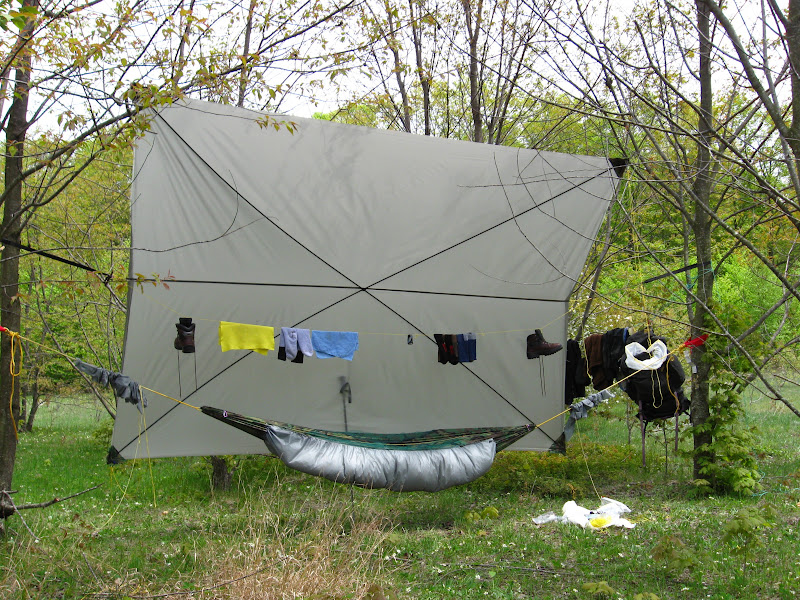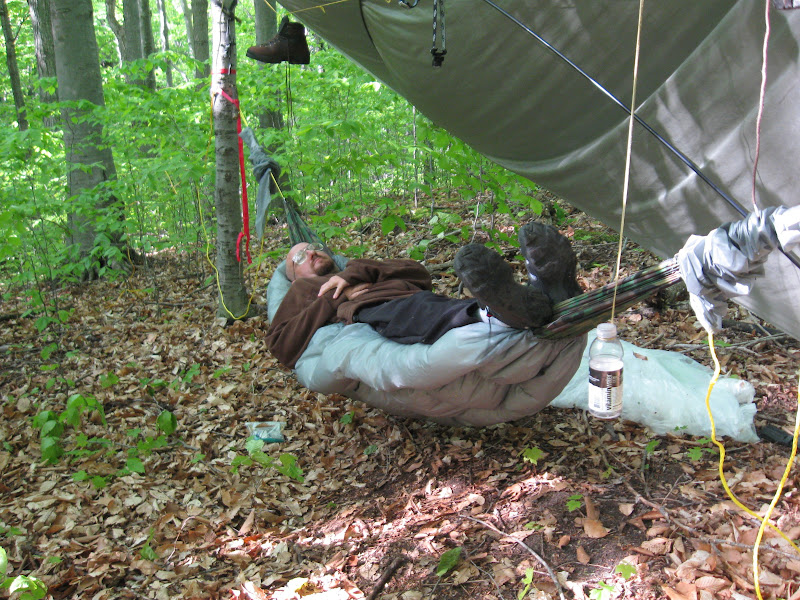Due to multiple requests, I am starting this thread on my fly.
I confess, I'm a little befuddled by the interest. I really enjoy my hammock, but the fly's nothing but a big sheet. But here goes...
My first hammock was the old WWII jungle hammock. It needed lots of tie outs, and they were always in the way. When I built my last fly... Who am I kidding. I didn't build anything. It was just simply a 5x9 sheet of sil-nylon, cut form the bolt. I draped it over a ridgeline, and used my walking sticks (old ski poles) as spreader bars.
(A bit of trivia here, if you safety pin the very corners together, it creates the top half of a tetrahedron. This gave me four walls of protection and a little heat retention in the winter months. I named this my "Delta House Homeless Shelter")
The nice thing about that, is that it was free floating. The weight of the poles held it down, but I could just lift it up to get under it. It dangled like a pendulum, and if the wind was blowing from one side, it would push that side closer against me, giving me ever better protection from that direction, while lifting up the opposite side for air.
Then this spring I planned a two week long solo trip to a wilderness island. I knew I would have bad weather, and for that length of time I wanted something more spacious. And thus was born my new fly.
The only sil-nylon I had left was narrower, but I had about 22' of it. (I'm cheap. I found this at Wal-Mart a couple years ago for a buck a yard, and so I hoarded it. lol.) So I cut it in half, and sewed the long edges together, making an 8x11 rectangle. Rather than living inside a triangle, I wanted a spacious dome, so I bought some tent poles from Quest Outfitters:
http://www.questoutfitters.com/tent_poles.htm
I sewed some pockets to the corners of the fly, and stitched about 4" of velcro to the very center. The poles cross in an X, and the velcro keeps them centered.
(In this picture I just pushed one side down and stuck my ski pole behind it while I snapped the picture. You can see the silhouette through the fly.)
I sewed loops halfway along the short sides, using the seam. I used string to pull those loops out to the trees, but you could also drape it over a ridgeline if you prefer.
Here you can see that I tied a string maybe 13' long from one loop to the other, and then actually clipped that loop to ropes which I tied to the trees. My logic was that by hanging things from this string, it would help pull the fly taught. At this time, I knew nothing of HammockForums or Amsteel, so I was still using stretchy nylon mason line.
The fly weighs 14 1/2 ounces, and the poles weigh 13 1/2 ounces.
The flexibility of the poles allows the corners to be pulled together however much you want. I typically let them extend all the way when I'm lounging,
but clip them together when I'm away. You can even fold it over backwards all the way if you want it out of the way.
I prefer to have the fly a completely separate unit form the hammock, so they can be raised or lowered independently.













 Reply With Quote
Reply With Quote

Bookmarks